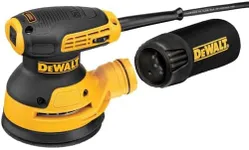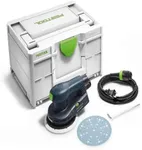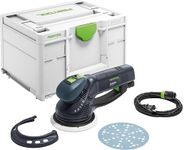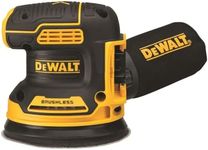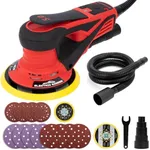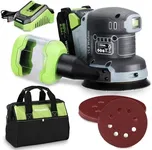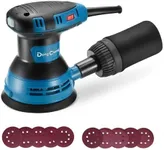Buying Guide for the Best Sanders For Decks
When choosing a sander for your deck, it's important to consider the specific needs of your project. Sanding a deck requires a tool that can handle large, flat surfaces and potentially rough wood. The right sander will make the job easier, faster, and provide a better finish. Here are some key specifications to consider when selecting a sander for your deck.Type of SanderThere are several types of sanders available, including belt sanders, orbital sanders, and random orbital sanders. Belt sanders are powerful and great for removing a lot of material quickly, making them ideal for rough sanding large areas. Orbital sanders are less aggressive and better for fine sanding and finishing. Random orbital sanders offer a balance between the two, providing both power and a smooth finish. Choose a belt sander for heavy-duty work, an orbital sander for finishing, or a random orbital sander for versatility.
Power SourceSanders can be corded or cordless. Corded sanders provide consistent power and are ideal for large projects where you don't want to worry about battery life. Cordless sanders offer more mobility and convenience, especially if your deck is far from a power source. If you have a large deck and access to power outlets, a corded sander might be the best choice. For smaller decks or more flexibility, consider a cordless model.
Motor PowerThe power of the sander's motor is measured in amps for corded models and volts for cordless models. Higher power means the sander can handle tougher jobs and work faster. For heavy-duty sanding, look for a sander with a motor of at least 7 amps (corded) or 18 volts (cordless). For lighter work or finishing, a lower power motor may suffice. Match the motor power to the intensity of your sanding needs.
Speed ControlVariable speed control allows you to adjust the sander's speed to match the task. Higher speeds are useful for removing material quickly, while lower speeds are better for fine sanding and finishing. A sander with variable speed control offers more versatility and can be used for a wider range of tasks. If you plan to use the sander for different stages of sanding, variable speed control is a valuable feature.
Dust CollectionSanding generates a lot of dust, which can be harmful to your health and make a mess. Many sanders come with built-in dust collection systems, such as bags or canisters, to capture dust as you work. Some models can also be connected to a shop vacuum for more efficient dust removal. A good dust collection system will keep your work area cleaner and reduce the amount of cleanup needed. If you want to minimize dust, look for a sander with an effective dust collection system.
Weight and ErgonomicsThe weight and design of the sander affect how comfortable it is to use, especially for extended periods. Lighter sanders are easier to handle and cause less fatigue, but heavier sanders may offer more stability and control. Ergonomic features, such as comfortable grips and vibration reduction, can also make a big difference. Consider how long you'll be using the sander and choose one that feels comfortable and manageable for you.
Pad Size and ShapeThe size and shape of the sander's pad determine how much area you can cover at once and how well you can reach into corners and edges. Larger pads cover more area quickly, while smaller pads offer more precision. Rectangular pads are good for flat surfaces, while round pads can be more versatile. For large, open areas of your deck, a larger pad may be more efficient. For detailed work or tight spaces, a smaller or more versatile pad shape might be better.
